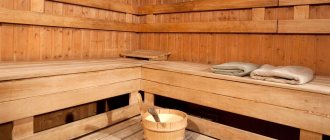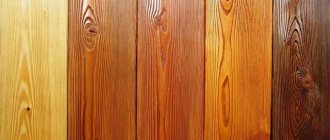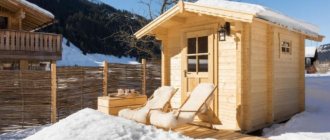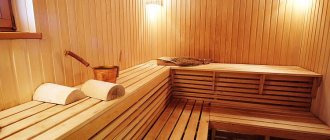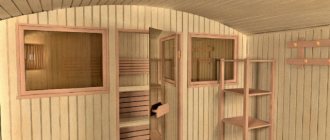The traditional material for building a bathhouse is wood. And this is no coincidence; the benefits of bath procedures are most fully manifested in a log steam room, in which a special microclimate is created, filled with the healing aromas of natural wood. But on the other hand, high humidity and extreme temperatures characteristic of a steam room do not have the best effect on wood, which quickly deteriorates in such conditions. Treating the bath with oil will help prevent destructive processes. In this regard, in the article we will focus on two main points: what are the best oils and impregnations to use in a steam room, as well as how to properly treat the internal surfaces of a bath with oil compositions.
What to cover with? And is processing necessary?
Let's start with a tricky question. The fact is that many bathhouse owners believe that the shelves in the bathhouse do not need to be treated with anything . At the same time, they easily accept the fact that wood, under the influence of heat and steam (humidity), quickly becomes dark and then collapses. It is believed that it remains environmentally friendly and this is more than enough, because the main thing is human health.
It is simply impossible not to agree with the last argument, but no one contrasts the beauty of the steam room with the health of its visitors .
Now, if there was such an impregnation for shelves in a bathhouse, which at the same time was completely harmless to our bodies and increased the durability of the tree - who would refuse it? IMPORTANT! Treatment of shelves in a bathhouse is not necessary only if its use raises concerns for human health.
Below we will consider in detail the compositions of various impregnations and their effects on humans. For now, let’s summarize briefly, naming the pros and cons of both choices.
Processing: pros and cons with and without it
Pros without processing:
- no chemicals evaporate at elevated temperatures and humidity from the surface of such a tree;
- the processes occurring with wood in the steam room are completely natural;
- the smells are only natural, which is especially pleasant when aromatic species are used - linden, for example, or cedar.
Cons without processing
- wood swells under the influence of moisture and contracts when dried, while its dimensions change and cracks may occur;
- it darkens;
- the shelves are exposed not only to heat and steam, but they are also exposed to human sweat (a caustic mixture of salts) and fat, which are absorbed into the wood, creating a characteristic smell in the steam room, by the way;
- with more or less ease (depending on the species), the tree succumbs to rot (mainly fungi) and collapses.
How to deal with rot
If the treatment turned out to be insufficient and the joists begin to rot, you can deal with the problem without completely replacing the floor. You need to start the fight against rot with thorough ventilation. Then you need to remove the floor boards, inspect the joists and find all areas of rot. Each affected area must be treated with one of the following compounds:
- Industrial products against rot and mold or other chlorine-based substances. They are used according to the instructions.
- A solution of a mixture of iron sulfate, potassium alum and table salt. Apply to the affected area with a brush. Completely destroys bacteria and fungi. The treatment must be repeated after a month for maximum results.
- Burning sulfur. In the bathhouse, you need to tightly close the windows and ventilation, and exclude access to pets. Sulfur powder is poured into an iron can, set on fire and quickly left the room. Close the door tightly behind you and leave it overnight. In the morning, the bathhouse is opened, the air is disinfected with a bucket of quicklime, and then ventilated. The method is effective, but fire hazardous.
- Hydrogen peroxide. Copes with mold and inhibits the rotting process. Safe for humans at any temperature. The solution is poured onto the affected areas and around them in a thin stream.
To work you need a large bottle of peroxideSource peroxide-prom.ru
- Vinegar. Apply to affected areas with a brush. It smells unpleasant, the pungent vinegar smell lingers for a long time.
- Soda solution. Effective against mold and rot, safe for people. After treatment, you can leave it on the boards; the soda will prevent re-rotting.
- Mechanical removal of rot. The affected area can be scraped off with a knife.
All recipes for treating wooden floors in a bathhouse from rotting and moisture are effective only with minor damage (dark spots, unpleasant odor, wood is slippery to the touch). If the rot has penetrated deeply, you need to replace the damaged joist and carefully inspect the neighboring ones.
Impregnation: the difference between a bathhouse and a sauna
We would call this question archivally important. Because it is the temperature that determines the evaporation of substances that impregnate the top layer of wood.
ON A NOTE! If it is small, then even the toxic(!) substances with which we cover the tree remain harmless to humans, hiding under the protective layers of other compounds.
And it is precisely the temperature that distinguishes a Russian bathhouse from a Finnish one . Therefore, let's agree that the compositions that we consider absolutely suitable for a Russian bath with its temperature not exceeding 60 degrees during the entire steaming period should not be recommended to sauna owners, where the temperature sometimes rises not only to the recommended 90, but also to 100-110 degrees (we simply do not consider higher).
The second, less important parameter is humidity. In a sauna it is low (5-15%), in a Russian sauna it is high (50%). In principle, a less humid sauna spoils the wood less, so you can actually do without impregnation at all, but the Finns rule here, and they believe that impregnation should be done at least for beauty and cleanliness.
The humidity of a Russian bath should be considered an argument in favor of water-repellent impregnations.
Blueprints
To simplify and speed up the process of making benches for a steam room, it is recommended to draw up a visual diagram of their structure and location.
The dimensions of each part are marked on the drawing. If necessary, sketches of shelves are made from different angles.
The figure clearly shows whether the design of the benches will be folding, stepped or removable.
The location and distance of the elements from the stove or boiler are indicated.
A separate drawing should show the overall picture of the bathhouse with the location of the steam room, shower room, and rest room (if provided).
Don't forget to indicate the height of the ceilings and the distance of the bottom shelf from the floor.
The name and consumption of material for the benches (lining, board) are indicated, and the fastening elements are noted.
What to soak: varieties and their purpose
You come to the store to choose a wood impregnation, and there are so many options there that your eyes widen.
In reality, you just need to distinguish between goals. A bathhouse is most often a separate building, in which, in addition to the steam room, there are other rooms . Many baths are built of wood or have wooden lining. There is wooden furniture everywhere. All this implies different purposes and compositions for them. Manufacturers of protective impregnations distinguish them as follows:
- What does the composition protect against: from water, from infection by fungi, from insects, from rodents, from fire;
- the composition is based on oil or water;
- what exactly is intended to protect: furniture, walls, floor, ceiling;
- product release form: gel, solution, aerosol;
- The wood will retain its natural color (bleach is a separate type) or will be tinted. In the latter case, a catalog of shades is offered.
In our particular case, we are looking for something to saturate the shelves in the bathhouse with. Now let’s decide on the task: what we want to protect the shelves from. It’s tempting to protect against everything at once, but without going into details for now, let’s say that antiseptics and fire retardants do not have a beneficial effect on our health, that is, it’s not worth protecting shelves from rot and fire .
Basically, the wood of the shelves is protected from water . In addition, not only for the sake of beauty, but also as a type of antiseptic , bleaches are used which return darkening wood to its original color.
We will now consider this limited set of what can be used to cover the shelves in a bathhouse.
Impregnations, colorless and colored
Everything here is quite simple: if you add one or another color to the impregnation, which has no or little effect on the original color of the wooden surface, then the result will be a colored impregnation . Wood painted with it will differ from wood coated with regular paint in that its texture will still be visible .
Each manufacturer of color impregnations accompanies its products with a catalog of colors, from which it is easy to choose the right one. Colors for impregnation are not sold separately.
ON A NOTE! Colored colors can be included in both water- and oil-based impregnations.
Oil
The most well-known property of oils and waxes is their hydrophobicity, that is, non-wetting by water. This is precisely what predetermined their use in the creation of water-repellent compounds for wood.
However, there is one important point: in the simplest case, a hydrophobic coating forms a film on the surface of an object, which differs in its thermal conductivity from wood. In practice, this means that the coating can burn if the air in the steam room is heated to a high temperature.
Therefore, manufacturers contrive to prepare oil for shelves in a bathhouse in such a way that the impregnation is absorbed into the wood without creating a noticeable film on the surface.
Usually bath oil has no color, but there are tinted ones too.
Bleaches
Experienced steamers are not deceived when they see light wood in the steam room - it won’t stay that way for long if you use the bathhouse regularly. However, their expectations may not be met if the owner of the steam room uses special impregnations that bleach the wood.
IMPORTANT! Any bleach will contain either a substance containing chlorine or hydrogen peroxide.
Strong oxidizing agents not only lighten, but also disinfect wood, destroying fungi and their spores too..
The depth of penetration of the composition also depends on the concentration of the active substance. Bleach can be in a more or less concentrated form when sold, and then, if desired, it can still be diluted with water.
Imported funds
For example, Supi Saunasuoja is a water-based acrylic impregnation for steam rooms. Holds temperature up to 120°C. Purpose – antiseptic protection against darkening and mold. There are colorless options - preserving the natural color of the wood, and tinted (allowing you to add shades). When choosing a color, it is recommended to do a test coating.
Apply with a wide flat brush or spray in two layers. Second layer after 2-3 hours What is covered – walls. Not recommended for bath shelves and ceilings. There are other impregnations from the same manufacturer for this purpose.
Supi Laudesuoja is an oil-based impregnation. The substance is odorless and practically colorless, although after application it “highlights” the natural texture of the wood. Purpose - water-repellent and dirt-repellent paraffin impregnation of deep penetration. Creates a protective film layer on the surface. Easy to clean. Apply in one layer to cleaned surfaces. What is covered - bath shelves.
To clean the wooden surfaces of the bathhouse, including before applying impregnation, use the acidic detergent Supi Saunapesu.
Purpose: disinfection and dissolution of lime deposits. In addition, it whitens the surface. The substance is odorless. What it cleans is bath shelves, walls and floors.
All three of these products are specially designed for use in bathhouses and allow you to carry out the process of not only impregnation, but also maintenance. And all of them belong to class M1 (the highest level of environmental safety)
Of course, there are many other foreign manufacturers, but in order not to occupy your attention for a long time, I chose the most “rated” one, based on reviews and purchases
Bathhouse shelves: how to treat them without causing harm to health?
Let's divide all impregnations into two conditional camps , in the first of which there is something that should not be used at all or with restrictions, in the second - the most safe.
Which ones are not recommended or can be used with limited use?
So we get to the important thing: how to distinguish between the harmfulness of a composition? First of all, let us agree to believe that what is harmful to lower forms of life will most likely be harmful to higher ones .
In any case, this rule works when it comes to antiseptics. Allowing the antiseptic to evaporate under the influence of high temperature and breathing it in, and sitting on the surface treated with it... is not the best solution. As for bleaches based on chlorine or hydrogen peroxide, the following should be taken into account: both are harmful to health, but both erode in a reasonable time. Peroxide generally decomposes into innocent water and oxygen. This happens even just in the light.
BY THE WAY! Have you already noted that bleach also works as an antiseptic?
You should absolutely not use anything from the list of exterior impregnations - this is something that cannot be used inside any room. But this is an obvious thing. But a variety of varnishes, including those that are actively promoted as suitable for use in baths and saunas...
Firstly, if you choose a varnish, then the one that is said to withstand the high temperature of the steam room. All the rest, if they are suitable for a bathhouse, are somewhere in its other rooms.
Secondly, varnish is not at all recommended for coating shelves . Perhaps someone will cover the window frame with it - both the area is small and the tree is protected.
ADVICE! Even when we see high-quality Finnish sauna varnishes on sale, we believe that they have no place there. A window frame in a steam room coated with varnish is normal. But everything else, including stones (yes, the Finns suggest varnishing stones) is not worth it.
In general, varnishes, antiseptics and fire retardants are not for the steam room !
Which ones are completely safe?
And yet I would like the wood in the steam room to last longer. And if it is not wetted with water, its preservation will increase. This means that we can recommend as completely safe those impregnations that repel water and do not form a film on the surface.
ADVICE! For better absorption after applying the composition, it is recommended to heat the oven. The excess is then simply removed with a cloth.
Actually, there are no other safe options - only some kind of oil wax or special oil for bathhouse shelves.
IMPORTANT! The difference between oils and oil waxes is the following: the depth of penetration of the composition and, as a consequence, the frequency of coating renewal. It is higher for oils from 0.5 to 2 years.
To pour or not to pour
A familiar dilemma: how to treat the shelves in the bathhouse or not treat it at all? The bathhouse is a stronghold of all that is pure and natural; any treatment with an uncharacteristic substance will immediately upset the idyllic balance, but sometimes it is impossible to leave the elements of the steam room without treatment. What should I do? First, let’s determine what negative factors affect wood and what the consequences are:
- In a traditional bath, the wooden elements of the shelf are exposed to high - 60-70 degrees Celsius, and high - over 70 degrees Celsius, temperature and absolute humidity, which in a steam bath can reach 75-80%. In addition, during the cold season, these same shelves are subject to alternating temperature influences. All this is fraught with linear vibration of the wood mass, which clearly causes disruption and, over time, destruction of its structure.
- High humidity is a paradise for microflora, and the moderate temperature observed in a steam room during periods of inactivity in the bath provokes the active development of colonies of microorganisms. Ultimately, they also destroy the tree, just like temperature fluctuations, but they do it faster and more obviously.
- Wood, over time, even in relatively favorable conditions, changes its original color, it becomes darker, and the pattern fades, the texture becomes less pronounced. Where the body rests, the eyes should also rest pleasantly, so the visual state of the interior is an important factor in maintaining the overall favorable “tone” of the bathhouse.
- Finally, the most key and aesthetically unpleasant factor. In conditions of high temperature, a person sweats intensely, and this is a natural and obviously beneficial effect of a bath. But the sweat-fat secretion is intensively absorbed into the thickness of the wood and over time becomes a breeding ground for microorganisms and, as a result, an unpleasant odor in the room.
In principle, the idea with replaceable shelves is good, however, it requires a well-thought-out design of the lid so that replacement is not difficult and occurs quickly and efficiently and, naturally, consumables made from commercial wood of decent quality are always available both in availability and price.
If this option is not possible, then it remains to carry out comprehensive protection of the product.
What's in it, what are they made from?
Unfortunately, most manufacturers do not want to reveal their secrets, sharing information with the consumer about the composition of their products. This is probably done because the ingredients are simple and affordable , and not everyone will want to pay for fancy packaging if it significantly increases the price.
(For example: do you know that caustic soda, which is part of almost all strong anti-fat products, can be bought much cheaper in its pure form? And this is the main active ingredient, other surfactants and fragrances are just there for company.)
From what we have been able to find out about, say, shelf oils, the expression “natural ingredients” hides polymerizing oils (most often linseed and hemp) and waxes. In addition to them, paraffin is also mentioned. In this regard, the question arises: what prevents you from making such impregnation yourself?
Can I do it myself?
Of course you can. And many do just that. Here is one of the possible recipes suitable for the steam room:
The proportion between linseed oil and wax is 92:8, 93:7, 94:6, 95:5. That is, we take 92-95 parts of oil and 7-5 parts of beeswax.
The oil must be prepared first. To do this, it is boiled for 20 minutes. During this period of time, excess water evaporates from it and the characteristic odor disappears.
Addition from site visitor Denis: about the fire hazard of boiling oil. First, hot oil vapors ignite before the oil boils. Secondly, if a drop of water gets in, the oil will flare up and not show up.
After boiling is completed, wax is added, which should be crushed in advance. As the mixture cools, it should be stirred to prevent the wax from curdling.
It is better to store the finished mixture in a glass container. Shelf life - no more than a year .
Well, for those who prefer not to bother with preparing oil wax, we will name the most well-known companies that make good impregnations of this type.
Which manufacturers and brands are good?
We will consider as good those from whom they take more often, whose names are well known to everyone.
First of all, as usual, I would like to name the Finns and the Germans.
TIKKURILA and TEKNOS are well-established Finnish companies. The first offers impregnations Supi Saunasuoja and Supi Laudesuoja . The second one has Satu Saunasuoja .
The German company ESKARO offers Saunaoil.
Slovenian BELINKA offers “ Sauna Oil - PARAFFIN ”. By the way, drying occurs within a day.
Among the Russian manufacturers we will name PINOTEX, SENEZH, NEOMID.
Criterias of choice
Oil is a traditional bath treatment product.
In former times, the wood in the steam room was covered with expensive oils of anise, rose, and lavender. They not only protected various log elements from moisture and rot, but also filled the room with a special natural aroma. Inexpensive hemp and linseed oils and wax were also used for processing. They have not lost their relevance today.
All existing oil compositions used in steam rooms can be divided into two large groups:
For treating walls and ceilings.
For impregnation of benches and other surfaces in direct contact with the skin.
General requirements for oils
Impregnation for a bath should provide reliable protection for the wood, and at the same time should not deprive it of its ability to breathe.
An important condition is the environmental friendliness of the oil composition.
Therefore, to cover the bath room you need to choose natural products. Synthetic impregnations contain chemical components that, when exposed to high temperatures, form harmful volatile compounds that are released into the atmosphere. In a small confined space, harmful substances are especially dangerous and can cause serious poisoning.
For a bath, it is necessary to use moisture-resistant impregnations that are well absorbed into the wood structure, protecting it from moisture.
There are special requirements for shelf oil. Its surface is constantly in contact with the skin, and a poor-quality composition will cause rashes and irritation. It should form a film on the wood, which can cause burns. It is important to use products with special marks for shelves.
How and with what to cover the shelves so that the coating lasts longer?
The durability of the coating on a wooden surface depends not only on the composition of the product applied, but also on the tool used, application conditions, number of layers, etc.
What is better to process - tool
If you purchased a store-bought product for bath shelves, the instructions will tell you what to use. However, there are not many options.
Either it will be
a brush (pay attention to the instructions - in some cases they write that it should be made of natural bristles ), or a clean cloth. In some cases, you can use a sprayer.
Again, different impregnation compositions can be either ready-to-use or require heating.
If you use homemade impregnation , then before starting work you need to heat it to 50-60 degrees.
The brush is used only if the impregnation is sufficiently liquid . The stripes it applies should not overlap so that “steps” are not created (this applies to hardening impregnations). The brush is very convenient for applying oils.
A cloth is better for waxing . When rubbing the thick mixture, try to distribute it evenly, but you don’t have to remove the excess right away. If, after applying the layer, you heat the oven, then the classic “waxing” will occur - the wax itself will spread as it should. (When waxing items not for a bath, they are heated with a hairdryer or burner.)
How many layers
The number of layers of impregnation is also usually specified in the instructions. Since the means are different, we will only venture to roughly name the number of layers and the time interval between them. Let's say it's two coats applied one hour apart.
The number of layers depends on both the properties of the impregnation and the porosity of the wood. The more pores, by the way, the higher the consumption of the product - it can increase by about two times.
ADVICE! Take your time to use the soaked shelf. Give it at least a day to absorb. Longer is better, because the point of using polymerizing oils is to let them dry. It's like oil painting - when the paint dries, the layer hardens completely.
Regarding the drying time : they are also different, in some cases a day is enough (according to the instructions), in others the time can last up to two weeks.
How often should the coverage be renewed?
The answer to this question depends on what tool you used. The fact is that oil impregnation, although it is easier to apply than wax impregnation, also lasts much less than the latter.
So, for renewing a layer of oil impregnation, the period is called from six months to 2 years, and for a wax impregnation - several years (without specification).
However, you should focus on the condition of the wood. If you used tinted impregnation, then you can see from it exactly where it came off. If the impregnation is colorless, focus on the condition of the wood - has it become wetted with water and swollen from it? In these cases, of course, there is no need to wait for the time promised by the manufacturer.
How to remove resin from boards
Removing the resin once will not get rid of it completely. Be aware that the operation will have to be repeated many times until all the resin flows out of the resin passages.
You can try to remove the resin from the boards in a bathhouse mechanically. Something like how the author of the video below does it:
You can try to wash it off. And there are quite a lot of options here. You can use solvents such as alcohol, kerosene, gasoline, acetone, nitro solvent, turpentine. All this is in its pure form.
You can make mixtures. For example, acetone works even better with ammonia. Apply a couple of times and scrub in with a brush until a foam of saponifying resin forms. After 15 minutes, rinse with warm water.
Another option is to use caustic soda. It also saponifies the resin. Dissolve the caustic in hot water and apply it to the resin with a plastic brush. Leave on for 5 minutes and reapply. Then, just as in the previous case, rub with a brush until foam forms, and then rinse. To neutralize alkali, rinse with vinegar solution
We described the precautions above

